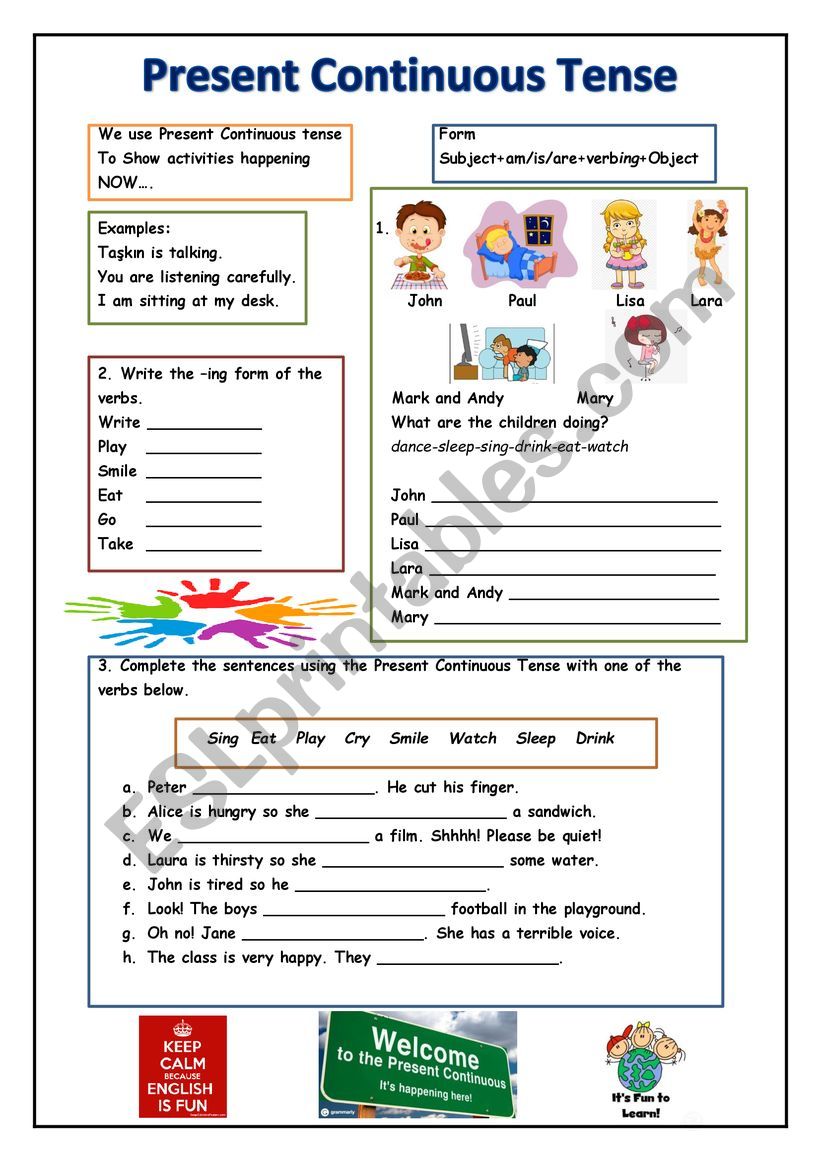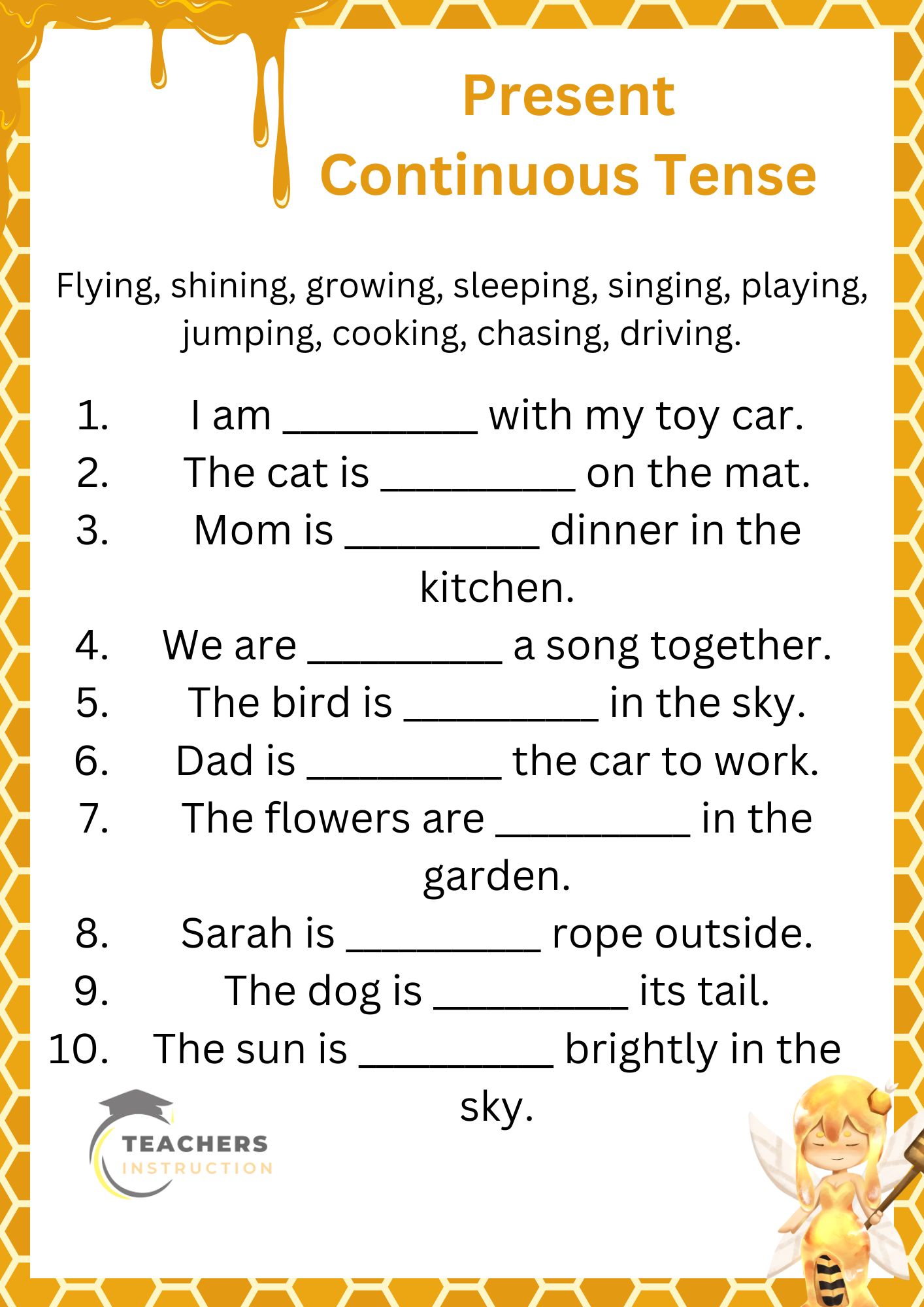
Mastering the Moment: The Indispensable Role of Present Continuous Worksheets
The English language, with its dynamic tenses, often presents a fascinating yet challenging landscape for learners. Among these, the Present Continuous tense stands out for its immediacy and versatility, describing actions happening right now, temporary situations, and even future plans. For both educators and students, grasping this tense is fundamental to effective communication. While theoretical explanations are crucial, practical application through exercises is where true understanding solidifies. This is precisely where the invaluable resource of Present Continuous worksheets comes into play.
This article delves into the multifaceted world of Present Continuous worksheets, exploring their pedagogical benefits, diverse types, effective design principles, and strategies for seamless integration into the language learning curriculum. We will examine how these tools can transform abstract grammatical rules into tangible, actionable knowledge, empowering learners to confidently navigate real-world conversations.

The Pedagogical Power of Present Continuous Worksheets

The benefits of utilizing Present Continuous worksheets in language instruction are manifold, extending beyond mere rote memorization to foster deeper comprehension and practical application.

- Reinforcement and Practice: Grammar rules, no matter how clearly explained, require repetition to sink in. Worksheets provide structured, repetitive practice that helps students internalize the correct form and usage of the Present Continuous. This constant exposure builds muscle memory for linguistic patterns, making correct usage more intuitive.
- Variety and Engagement: A well-designed worksheet offers a diverse range of exercise types, preventing monotony and catering to different learning styles. From gap-fills to picture descriptions, these varied activities keep students engaged and interested, transforming potentially dry grammar lessons into interactive challenges.
- Self-Paced Learning: Worksheets allow students to work at their own pace, reviewing concepts as needed and building confidence without the pressure of a group setting. This independent learning fosters autonomy and responsibility, crucial skills for lifelong language acquisition.
- Assessment and Feedback: For educators, worksheets serve as an excellent diagnostic tool. They quickly reveal areas where students are struggling, allowing teachers to pinpoint common errors and adjust their teaching strategies accordingly. For students, immediate feedback (often via answer keys) allows for self-correction and a clearer understanding of their mistakes.
- Preparation for Productive Skills: The mastery of grammatical structures like the Present Continuous is a prerequisite for developing productive skills such as speaking and writing. Worksheets provide the foundational practice necessary for students to construct grammatically correct sentences, which they can then apply in more complex communicative tasks.
- Bridging Theory and Practice: Worksheets effectively bridge the gap between abstract grammatical rules and their practical application. By presenting the tense in various contexts – dialogues, narratives, descriptions – students learn not just what the Present Continuous is, but how and when to use it appropriately.



Diverse Types of Present Continuous Worksheets

From foundational exercises to more complex tasks, the variety of available Present Continuous worksheets is vast, each serving a unique purpose in the learning progression.
- Gap-Fill Exercises: These are perhaps the most common and fundamental. Students are given sentences with missing verbs, which they must complete using the correct Present Continuous form.
- Example: She _____ (read) a book right now.

- Sentence Completion: Similar to gap-fills, but often requiring students to complete a sentence based on a prompt or a given context, encouraging more creative sentence construction.
- Example: Look! The children _____. (play in the park)
- Matching Exercises: These can involve matching sentences to corresponding pictures, questions to answers, or even verb infinitives to their correct Present Continuous forms. This visual and logical association aids comprehension.
- True/False Statements: Students read sentences using the Present Continuous and determine if they are grammatically correct or logically true based on a given context (e.g., a picture or short text). This encourages critical thinking about usage.
- Error Correction: Students are presented with sentences containing grammatical errors (e.g., incorrect verb forms, missing auxiliary verbs) related to the Present Continuous, and they must identify and correct them. This hones their error detection skills.
- Sentence Transformation: Learners transform sentences from one tense to the Present Continuous, or from affirmative to negative or interrogative forms, reinforcing the structural rules.
- Example: He eats lunch. (Transform to Present Continuous) -> He is eating lunch.
- Picture Description: Students describe what is happening in a given image using multiple Present Continuous sentences. This is excellent for developing observational skills and applying the tense in a natural, descriptive context.
- Dialogue Completion/Creation: Worksheets can provide incomplete dialogues where students fill in the blanks using the Present Continuous, or prompts for students to create their own short conversations based on a scenario. This integrates the tense into functional communication.
- Writing Prompts: Students are given a scenario or a set of questions that require them to write a short paragraph or story using the Present Continuous. This encourages extended writing practice.
- Listening Comprehension with Gaps: Students listen to an audio clip (e.g., a dialogue, a description) and fill in missing Present Continuous verbs or phrases in a provided transcript. This combines listening skills with grammar practice.
- Role-Playing Scenarios: While not strictly a "worksheet" in the traditional sense, prompts on a worksheet can guide students through a role-play where they must use the Present Continuous (e.g., describing what people are doing in a busy street).

Designing Effective Present Continuous Worksheets
Creating effective Present Continuous worksheets requires thoughtful consideration of pedagogical principles and student engagement.
- Clear Instructions: Ambiguity is the enemy of learning. Instructions must be concise, unambiguous, and easy for students to understand, perhaps with a clear example provided.
- Appropriate Difficulty: Worksheets should be tailored to the learners’ proficiency level. Beginner worksheets might focus on simple affirmative sentences, while advanced ones could incorporate negatives, questions, adverbs of time, and more complex scenarios.
- Varied Exercise Types: As discussed, mixing different exercise formats keeps students engaged and caters to diverse learning preferences.
- Contextualization: Grammar should not be taught in isolation. Present the Present Continuous within meaningful contexts – short stories, dialogues, real-life scenarios – to show its practical application. Avoid random lists of verbs.
- Engaging Content: Whenever possible, make the content relatable and interesting to your students. Use names, places, and activities that resonate with their age group and cultural background. Incorporate humor or intriguing facts.
- Visual Aids: Pictures, diagrams, and illustrations can significantly enhance comprehension and make worksheets more appealing, especially for visual learners.
- Scaffolding: Start with easier tasks and gradually increase the complexity. Provide hints or partial answers for more challenging sections if needed.
- Answer Keys: For self-study or peer-correction, a clear answer key is invaluable. It empowers students to take ownership of their learning and receive immediate feedback.
- Space for Answers: Ensure there is ample, clearly designated space for students to write their answers neatly.
Integrating Worksheets into Lesson Plans
Worksheets are not standalone islands of learning; they are powerful components of a larger pedagogical ecosystem. Seamless integration into lesson plans maximizes their impact.
- Pre-Teaching and Explanation: Before distributing any worksheet, ensure students have a foundational understanding of the Present Continuous. Explain its form (subject + am/is/are + verb-ing) and its common uses (actions happening now, temporary actions, future plans). Provide clear examples.
- Guided Practice: Begin by completing a few exercises together as a class. This allows you to model the correct approach, answer questions, and clarify any misunderstandings in real-time. This reduces anxiety and builds confidence.
- Independent Practice: Once students are comfortable, assign the remaining exercises for independent completion. This can be done individually, in pairs, or small groups, depending on the activity type and your pedagogical goals.
- Review and Correction: After completion, review the answers. This can involve students checking their own work with an answer key, peer-correction, or a whole-class review led by the teacher. Focus on explaining why an answer is correct or incorrect, not just stating the right answer.
- Follow-Up Activities: Worksheets can serve as springboards for further communicative activities. For example, a picture description worksheet can lead to a speaking activity where students describe their own daily routines, or a dialogue completion exercise can be turned into a role-play.
- Homework and Assessment: Worksheets are ideal for homework assignments, reinforcing learning outside the classroom. They can also be adapted into short quizzes or formative assessments to gauge comprehension.
Common Challenges and Solutions
While Present Continuous worksheets are incredibly beneficial, educators might encounter some challenges.
- Challenge: Student Disengagement. If worksheets are monotonous or too challenging, students may lose interest.
- Solution: Incorporate fun elements, real-world scenarios, and competitive activities (e.g., a race to complete correctly). Ensure variety in exercise types.
- Challenge: Difficulty Differentiation. Students in the same class often have varying proficiency levels.
- Solution: Create tiered worksheets (e.g., "Level 1" and "Level 2") or offer optional extension activities for advanced learners. Provide extra support or simplified versions for struggling students.
- Challenge: Over-reliance on Worksheets. Solely relying on worksheets can lead to passive learning and insufficient practice of productive skills.
- Solution: Balance worksheet activities with interactive games, speaking drills, group projects, and creative writing tasks. Worksheets should complement, not replace, other teaching methodologies.
- Challenge: Time Constraints. Preparing diverse and engaging worksheets can be time-consuming.
- Solution: Utilize online resources (many websites offer free, printable worksheets), adapt existing materials, or collaborate with fellow teachers to share resources.
Conclusion
The Present Continuous tense, with its dynamic nature, is a cornerstone of English communication. For learners to truly master it, a combination of clear explanation and extensive practice is essential. Present Continuous worksheets stand as an indispensable tool in this journey, offering structured, varied, and engaging opportunities for students to internalize the grammatical rules and confidently apply them.
From reinforcing foundational concepts to fostering independent learning and preparing for real-world communication, the strategic use of these worksheets can significantly enhance the language learning experience. By thoughtfully designing and seamlessly integrating them into lesson plans, educators can empower their students to not just understand, but truly live the moment in English. The continuous action of learning, much like the Present Continuous tense itself, is an ongoing process, and well-crafted worksheets are vital companions on that journey.
